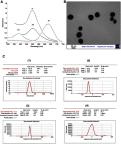Antifungal effects of indolicidin-conjugated gold nanoparticles against fluconazole-resistant strains of Candida albicans isolated from patients with burn infection
- PMID: 31409990
- PMCID: PMC6646856
- DOI: 10.2147/IJN.S207527
Antifungal effects of indolicidin-conjugated gold nanoparticles against fluconazole-resistant strains of Candida albicans isolated from patients with burn infection
Abstract
Background: Candida albicans as an opportunistic fungus is one of the most important causes of late-onset morbidity and mortality in patients with major burns and severely impaired immune system. In recent years, the emergence of resistance to opportunistic fungi and toxicity of antimicrobial drugs make it necessary to develop new drugs. Methods: In the present study, we investigated anticandidal effects of indolicidin, as a representative of host defense peptide, conjugated with gold nanoparticles in fluconazole-resistant clinical isolates of C. albicans. After characterizing the conjugation of indolicidin using biophysical methodologies, the cytotoxicity and hemolytic activity of the nanocomplex were examined. In addition, the expression level of ERG11, responsible for antifungal resistance, and the immunomodulatory effect of peptide-nanomaterial conjugates were assessed. Results: Our data indicated that the nanocomplex was nontoxic for the fibroblast cells and erythrocytes. Treatment with the nanocomplex significantly reduced the expression levels of the ERG11 gene in fluconazole-resistant C. albicans isolates and the iNOS gene in macrophages. Conclusion: The study data provides a chance to develop innovative therapies for the treatment of C. albicans burn infections. However, further investigation is required to examine the efficiency of the nanocomplex.
Keywords: Candida albicans; antimicrobial peptides; burn infection; gold nanoparticles; indolicidin.
Conflict of interest statement
The authors report no conflicts of interest in this work.
Figures







Similar articles
-
Synthesis, characterization and antifungal activity of a novel formulated nanocomposite containing Indolicidin and Graphene oxide against disseminated candidiasis.J Mycol Med. 2018 Dec;28(4):628-636. doi: 10.1016/j.mycmed.2018.07.009. Epub 2018 Aug 17. J Mycol Med. 2018. PMID: 30126717
-
Antifungal peptides: a potential new class of antifungals for treating vulvovaginal candidiasis caused by fluconazole-resistant Candida albicans.J Pept Sci. 2017 Mar;23(3):215-221. doi: 10.1002/psc.2970. Epub 2017 Jan 19. J Pept Sci. 2017. PMID: 28105725
-
Mechanisms of resistance to fluconazole in Candida albicans clinical isolates from Iranian HIV-infected patients with oropharyngeal candidiasis.J Mycol Med. 2016 Mar;26(1):35-41. doi: 10.1016/j.mycmed.2015.10.007. Epub 2015 Nov 25. J Mycol Med. 2016. PMID: 26627124
-
The genetic basis of fluconazole resistance development in Candida albicans.Biochim Biophys Acta. 2002 Jul 18;1587(2-3):240-8. doi: 10.1016/s0925-4439(02)00087-x. Biochim Biophys Acta. 2002. PMID: 12084466 Review.
-
Combination of fluconazole with non-antifungal agents: a promising approach to cope with resistant Candida albicans infections and insight into new antifungal agent discovery.Int J Antimicrob Agents. 2014 May;43(5):395-402. doi: 10.1016/j.ijantimicag.2013.12.009. Epub 2014 Jan 22. Int J Antimicrob Agents. 2014. PMID: 24503221 Review.
Cited by
-
A comprehensive review on potential applications of metallic nanoparticles as antifungal therapies to combat human fungal diseases.Saudi Pharm J. 2023 Sep;31(9):101733. doi: 10.1016/j.jsps.2023.101733. Epub 2023 Aug 6. Saudi Pharm J. 2023. PMID: 37649674 Free PMC article. Review.
-
Structural Characterization, Cytotoxicity, and the Antifungal Mechanism of a Novel Peptide Extracted from Garlic (Allium sativa L.).Molecules. 2023 Mar 30;28(7):3098. doi: 10.3390/molecules28073098. Molecules. 2023. PMID: 37049861 Free PMC article.
-
Antifungal activity of indolicidin-derived peptide In-58 against Sporothrix globosa in vitro and in vivo.Front Med (Lausanne). 2024 Sep 12;11:1458951. doi: 10.3389/fmed.2024.1458951. eCollection 2024. Front Med (Lausanne). 2024. PMID: 39328314 Free PMC article.
-
Antifungal Effect of Nanoparticles against COVID-19 Linked Black Fungus: A Perspective on Biomedical Applications.Int J Mol Sci. 2022 Oct 19;23(20):12526. doi: 10.3390/ijms232012526. Int J Mol Sci. 2022. PMID: 36293381 Free PMC article. Review.
-
Antimicrobial Peptides: a New Frontier in Antifungal Therapy.mBio. 2020 Nov 3;11(6):e02123-20. doi: 10.1128/mBio.02123-20. mBio. 2020. PMID: 33144376 Free PMC article. Review.
References
-
- Holzheimer R, Dralle H. Management of mycoses in surgical patients-review of the literature. Eur J Med Res. 2002;7(5):200–226. - PubMed
MeSH terms
Substances
LinkOut - more resources
Full Text Sources
Medical

